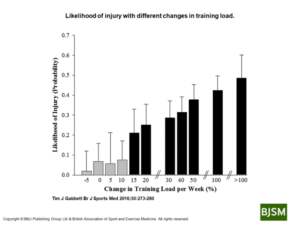
![]() By Dr. John R. Mishock
By Dr. John R. Mishock
In organized sports from youth to pro there are approximately 4-6 million injuries each year. The majority of these injuries occur as sprains and strains of the upper and lower extremity. (Hopkinsmedicine.org) Many of these injuries are preventable with proper exercise training and load management of training/competition volume, which ultimately reduces health care costs and minimizes lost playing time keeping the athlete on the field. Keep in mind that durability is as important is ability.
In sports training and competition, it is imperative that there is a balance between training/competition and rest/recovery in order to have optimal physiological gains while keeping the athlete healthy and performing at their best during key parts of the season. Dr. Tim Gabbet has provided outstanding graphs as part of his study in British Journal of Sports Medicine (Gabbett, 2016). I will use his graphs as a guide to better understand how we coaches, trainers, and health care providers can reduce injury and optimize sports performance.
Graph 1: As fitness increases the performance improves. 2. As the fitness increases at a gradual level the injuries will reduce showing the importance of training in injury prevention. 3. As injuries ramp up performance reduces. In order to optimize the training affect an increase of 10-20% of training volume per week is recommended.

Graph 2: 1. Early in the season, injuries occur more readily as training volume ramps up. The increased injury rate may be due to athletes entering the preseason at a low fitness level or the coaches and trainers ramping up the training volume too fast. 2. Injuries occur late in games when the cumulative load increases, causing fatigue. In most sports, fatigue is the most significant predictor of injury. Coaches and trainers must identify fatigue that could lead to injury and moderate or end the activity.

Graph 3: 1. As the training/competition load is maximized, the injury rate is highest (Feb). 2. When training/competition load is balanced, the injury rate is maintained at a low level (May-Aug).

Graph 4: 1. When training/competition load increases, the injury rate increases. An increase in training volume/load of 10-20% is the sweet spot where injury rates are lower, creating an optimal training effect. The objective is to have a training effect that enhances sports performance and prevents injury. Progress the training volume, load, and intensity to less than 20% per week.

Following the above training and competition principles will reduce injury and optimize performance.
Dr. Mishock is one of only a few clinicians with doctorate level degrees in both physical therapy and chiropractic in the state of Pennsylvania.
He has authored two books; “Fundamental Training Principles: Essential Knowledge for Building the Elite Athlete”, and “The Rubber Arm; Using Science to Increase Pitch Control, Improve Velocity, and Prevent Elbow and Shoulder Injury” both can be bought on Amazon.
If pain or limited function is keeping you from doing the activities you enjoy,
We can help!
Reduce pain and increase function
Call for a FREE Phone Consultation or to schedule your visit (610)327-2600
REQUEST AN APPOINTMENT
https://mishockpt.com/request-appointment/
Locations: Gilbertsville, Skippack, Phoenixville, Steiner Medical, Boyertown, Pottstown, and Limerick (inside the Spring Valley YMCA).
Appointments available 7:00am to 8:00pm, ALL locations, most days!
Saturday Appointments available
Visit our website to REQUEST AN APPOINTMENT, read informative articles, meet our physical therapy staff, and learn about our treatment philosophy.
